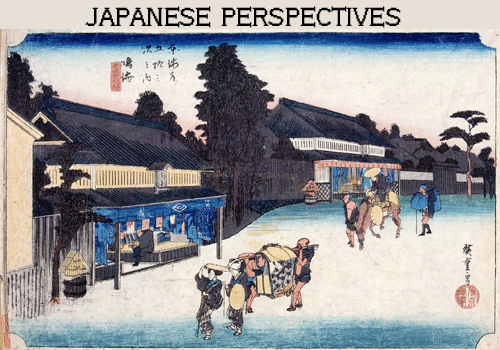|

Thanks to globalization, overnight air freight and aquaculture, Japanese and American sushi aficionados eat -- more or less -- the same stuff. The farmed hamachi and toro served in Nagoya is, on a commodity basis, virtually indistinguishable from the hamachi and toro served at the finest sushi-ya in Newport Beach.
But the sushi experience remains vastly different, as Japanese and American patrons can't help but bring divergent cultural filters to the bar. Japanese visitors eating sushi in the United States are stunned by what they see, even in our better establishments. First, it's outrageously cheap compared to what they're accustomed to seeing at home. But more than that, it's the way in which Japanese partake:
A ladder of flavors. The Japanese appreciate sushi the way Americans appreciate the latest paperback thriller. You've got to carefully build suspense. That means starting with lighter, more delicate flavors and ending with stronger, heavily marinated items. The exact sequence is a matter of endless dispute, but generally, a classic sushi meal would start with a variety of shiromi (white fish such as tai or hirame) and end with brawny two-fisted flavors such as saba and iwashi.
It's all about variety. To most Japanese, it would be simply piggish and unthinkable to order eight pieces of sake or hamachi -- or eight pieces of anything. The idea is to sample a little of the best of everything. It's the difference between a walk in a beautiful garden and a walk through a Christmas tree farm. Ordering mass quantities of one or two favorite nigiri is like throwing $5 in a jukebox and playing the same song 10 times. What's the point?
Eat with your eyes. Much more so than Americans, Japanese are keenly mindful of sushi's craft. Kata (proper form) matters. And they'll notice if something lacks the proper balance. That pertains to the balance of fish to rice, the balance of sugar to vinegar in the rice, the balance of flavors in sauces. The presentation on the geta is as important as the flavors. Is the fish cut properly? How are the various pieces composed as a unit? Ninety-nine percent of Americans don't take that critical moment to really look at the geta before digging in. This obliviousness is something that confounds many Japanese.
Rice in its many forms. Sake is not a traditional drink with sushi. To the Japanese, the idea of eating rice and drinking rice (wine) at the same time just seems unbalanced.
Other things that don't go with sushi. To Japanese, mixing fried foods of any kind with sushi seems about as appetizing as spooning horseradish on a hot-fudge sundae. The gigantic American-style fancy rolls with tempura, mayo, sriracha sauce, pineapple guava puree and 18 other ingredients are fascinating to the Japanese as oddities -- but they're not considered real sushi. Most sushi parlors in Japan will not serve any fried or grilled items, with the notable exception of eel. In Japan, if you want ramen or bar food, you go to a noodle shop or an izakaya, not a sushi bar.
A time and place for everything. Despite globalization, some sushi tane are indelibly tagged in the Japanese mind as seasonal flavors. These associations are as clear as Americans' identifying sweet corn and watermelon with summer cookouts. Kazunoko? That's a New Year's delicacy. Kanpachi means summer's almost here. And kohada's best in winter. Whatever the fish, hatsuryo (the first catch of the season) is highly auspicious -- and ruinously expensive -- in Japan.

Copyright 2006-2008, David Plotnikoff. All rights reserved. No part of this document may be reproduced without permission.
|